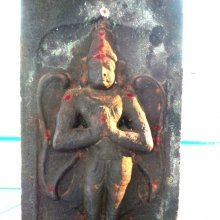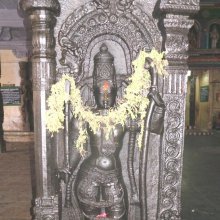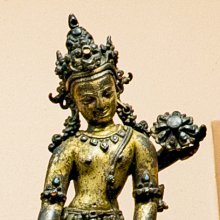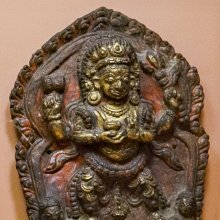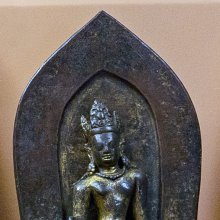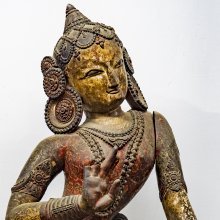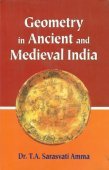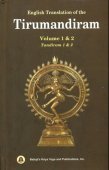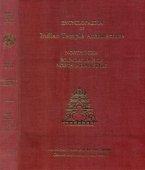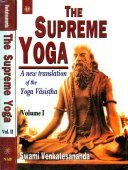Expression: 3 definitions
Introduction:
Expression means something in Hinduism, Sanskrit. If you want to know the exact meaning, history, etymology or English translation of this term then check out the descriptions on this page. Add your comment or reference to a book if you want to contribute to this summary article.
Images (photo gallery)
(+23 more images available)
In Hinduism
Natyashastra (theatrics and dramaturgy)
Source: Shodhganga: Elements of Art and Architecture in the Trtiyakhanda of the Visnudharmottarapurana (natya)Expressions, Emotions and Feelings (in Sanskrit drama) are conveyed through Sātvikābhinaya, which represents one of the four divisions of Abhinaya or “ways to convey or represent one’s emotion to others” (in Sanskrit Drama), according to the Viṣṇudharmottarapurāṇa, an ancient Sanskrit text which (being encyclopedic in nature) deals with a variety of cultural topics such as arts, architecture, music, grammar and astronomy.—Sātvikābhinaya that deals with the feelings, emotions and expressions, conveyed by the actors. Flow of tears, horripilation, sweating, throbbing of heart and faultering speech come under the sātvikābhinaya. It is important to note here that in the Nāṭyaśāstra the word bhāvabyañjaka is used for the sātvikābhinaya. When the inner ideas of a dramatist are expressed by means of words, gestures, facial expressions and the representation of sattva, those are called bhāvas. [...]

Natyashastra (नाट्यशास्त्र, nāṭyaśāstra) refers to both the ancient Indian tradition (shastra) of performing arts, (natya—theatrics, drama, dance, music), as well as the name of a Sanskrit work dealing with these subjects. It also teaches the rules for composing Dramatic plays (nataka), construction and performance of Theater, and Poetic works (kavya).
Shilpashastra (iconography)
Source: Shodhganga: Elements of Art and Architecture in the Trtiyakhanda of the Visnudharmottarapurana (shilpa)Expressions (in a painting) are conveyed through the six limbs of Painting (citra), according to the Kāmasūtra and Viṣṇudharmottarapurāṇa, an ancient Sanskrit text which (being encyclopedic in nature) deals with a variety of cultural topics such as arts, architecture, music, grammar and astronomy.—The Viṣṇudharmottarapurāṇa says that proper position, measurement, use of space, gracefulness, expression, similarity, scale of size to increase or to decrease are the eight qualities of a good Painting.

Shilpashastra (शिल्पशास्त्र, śilpaśāstra) represents the ancient Indian science (shastra) of creative arts (shilpa) such as sculpture, iconography and painting. Closely related to Vastushastra (architecture), they often share the same literature.
Vedanta (school of philosophy)
Source: ORA: Amanaska (king of all yogas): (Advaita Vedanta)Expressions are denoted in the Sanskrit language as Abhilāpa, according to the Māṇḍūkyopaniṣatkārikā 3.37.—Accordingly, while discussing the no-mind state: “Devoid of all expression (sarva-abhilāpa) and having transcended all thought, Samādhi is very peaceful, its light perpetually [illuminates], [and it is] immovable and fearless”.

Vedanta (वेदान्त, vedānta) refers to a school of orthodox Hindu philosophy (astika), drawing its subject-matter from the Upanishads. There are a number of sub-schools of Vedanta, however all of them expound on the basic teaching of the ultimate reality (brahman) and liberation (moksha) of the individual soul (atman).
See also (Relevant definitions)
Ends with: Facial expression, Physical expression.
Full-text (+1964): Abhinaya, Abhilapa, Mottayita, Upalakshana, Abhinandana, Vakrokti, Apaprayoga, Ukti, Vinnatti, Drishtiraga, Bhavaka, Dhanyavada, Emotion, Roshakshepa, Bhava, Nakadhurai, Nakadharai, Lakshana, Vyanjana, Aharyabhinaya.
Relevant text
Search found 363 books and stories containing Expression; (plurals include: Expressions). You can also click to the full overview containing English textual excerpts. Below are direct links for the most relevant articles:
The Tattvasangraha [with commentary] (by Ganganatha Jha)
Verse 571 < [Chapter 10 - The Examination of the First Category—‘Substance’]
Verse 1932-1933 < [Chapter 22 - Lokāyata—Materialism]
Verse 596-598 < [Chapter 10 - The Examination of the First Category—‘Substance’]
Gati in Theory and Practice (by Dr. Sujatha Mohan)
Nṛtta as a division of Āṅgika-abhinaya < [Chapter 1 - Nāṭya]
Observations based on Nāṭyaśāstra < [Chapter 5 - Conclusion]
Gati—Etymological meaning and description < [Chapter 2 - Concept and technique of Gati]
The Agni Purana (by N. Gangadharan)
Chapter 340 - Description of diction and mode (rīti)
Chapter 361 - The indeclinables (avyaya-varga)
Chapter 337 - Description of the characteristics of a kāvya (kāvylakṣaṇa)
Vakyapadiya of Bhartrihari (by K. A. Subramania Iyer)
Verse 3.7.152 < [Book 3 - Pada-kāṇḍa (7): Sādhana-samuddeśa (On the Means)]
Verse 3.6.8 < [Book 3 - Pada-kāṇḍa (6): Dik-samuddeśa (On Position)]
Verse 3.14.64 < [Book 3 - Pada-kāṇḍa (14): Vṛtti-samuddeśa (On Ccomplex Formation)]
Philosophy of language in the Five Nikayas (by K.T.S. Sarao)
11. Sense and Reference < [Chapter 2 - Concept of Philosophy of Language]
3. Semantics (study of formal theories of meaning) < [Chapter 3 - Language and Meaning as Reflected in the Five Nikāyas]
10. Semantics and Truth < [Chapter 2 - Concept of Philosophy of Language]
Yoga-sutras (Vedanta Commentaries)
Sūtras 12-14 < [Part IV - Liberation]
Sūtras 6-14 < [Part I - Yoga and its Aims]
Sūtra 50 < [Part II - Yoga and its Practice]
Related products
(+6 more products available)
